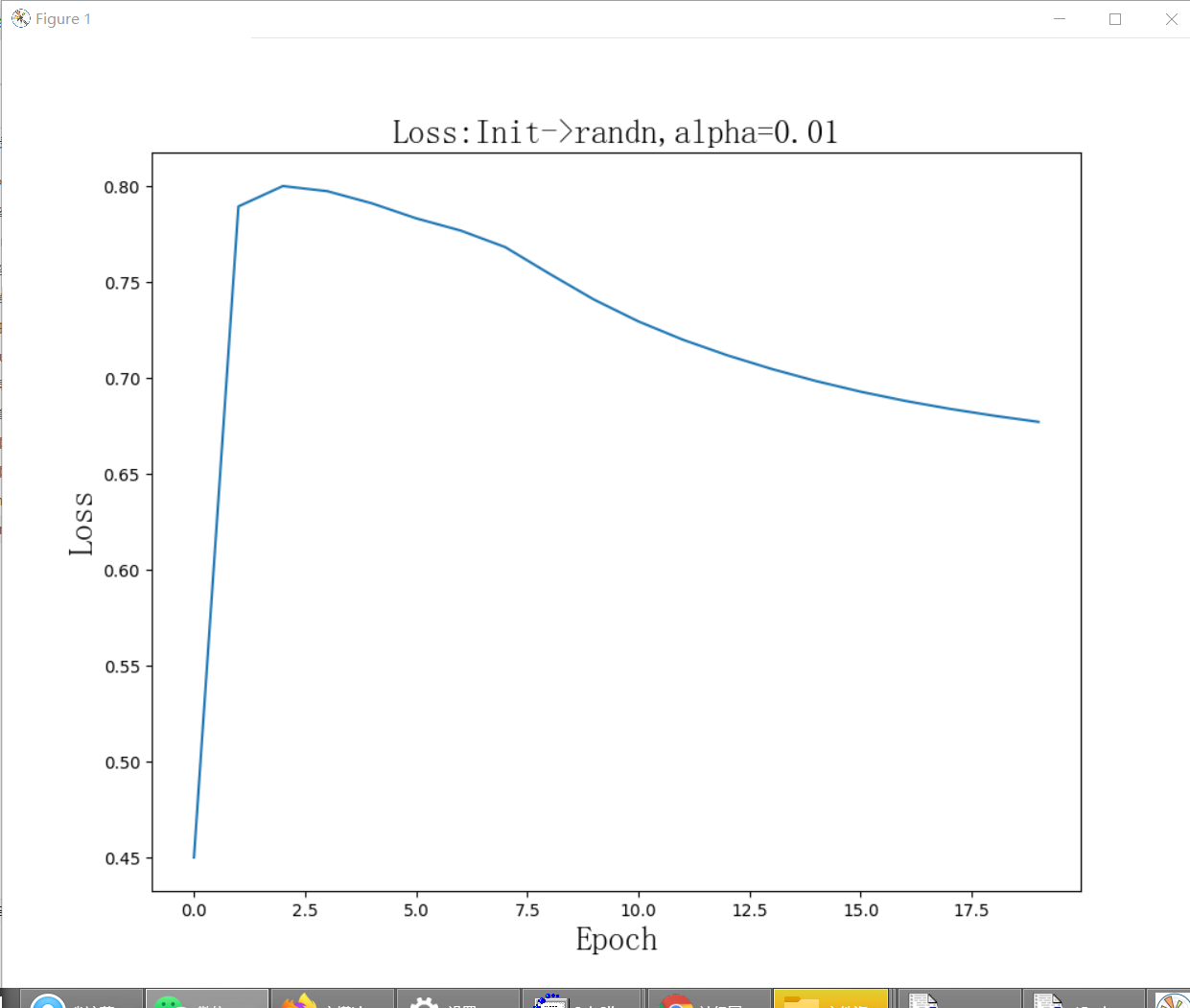```
#!/usr/bin/python3
# coding:utf-8
# @Author: Lin Misaka
# @File: net.py
# @Data: 2020/11/30
# @IDE: PyCharm
from os import listdir
import numpy as np
import matplotlib.pyplot as plt
import pickle
# 函数img2vector将图像转换为向量
def img2vector(filename):
returnVect = np.zeros((1, 1024))
fr = open(filename)
for i in range(32):
lineStr = fr.readline()
for j in range(32):
returnVect[0, 32 * i + j] = int(lineStr[j])
return returnVect
# 读取手写字体txt数据
def handwritingData(dataPath):
hwLabels = []
FileList = listdir(dataPath) # 1 获取目录内容
m = len(FileList)
digitalmat = np.zeros((m, 1024))
for i in range(m):
# 2 从文件名解析分类数字
fileNameStr = FileList[i]
fileStr = fileNameStr.split('.')[0] # take off .txt
classNumStr = int(fileStr.split('_')[0])
hwLabels.append(classNumStr)
#print(digitalmat[i, :].shape)#(1024,)
#print(img2vector(dataPath + '/%s' % fileNameStr).shape) # (1, 1024)
#print(digitalmat[i].shape) # (1024,)
digitalmat[i] = img2vector(dataPath + '/%s' % fileNameStr)
return digitalmat, hwLabels
# diff = True求导
def Sigmoid(x, diff=False):
def sigmoid(x): # sigmoid函数
return 1 / (1 + np.exp(-x))
def dsigmoid(x):
f = sigmoid(x)
return f * (1 - f)
if (diff == True):
return dsigmoid(x)
return sigmoid(x)
# diff = True求导
def SquareErrorSum(y_hat, y, diff=False):
if (diff == True):
return y_hat - y
return (np.square(y_hat - y) * 0.5).sum()
class Net():
def __init__(self):
# X Input
self.X = np.random.randn(1024, 1)
self.W1 = np.random.randn(16, 1024)
self.b1 = np.random.randn(16, 1)
self.W2 = np.random.randn(16, 16)
self.b2 = np.random.randn(16, 1)
self.W3 = np.random.randn(10, 16)
self.b3 = np.random.randn(10, 1)
self.alpha = 0.01 #学习率
self.losslist = [] #用于作图
def forward(self, X, y, activate):
self.X = X
self.z1 = np.dot(self.W1, self.X) + self.b1
self.a1 = activate(self.z1)
self.z2 = np.dot(self.W2, self.a1) + self.b2
self.a2 = activate(self.z2)
self.z3 = np.dot(self.W3, self.a2) + self.b3
self.y_hat = activate(self.z3)
Loss = SquareErrorSum(self.y_hat, y)
return Loss, self.y_hat
def backward(self, y, activate):
self.delta3 = activate(self.z3, True) * SquareErrorSum(self.y_hat, y, True)
self.delta2 = activate(self.z2, True) * (np.dot(self.W3.T, self.delta3))
self.delta1 = activate(self.z1, True) * (np.dot(self.W2.T, self.delta2))
dW3 = np.dot(self.delta3, self.a2.T)
dW2 = np.dot(self.delta2, self.a1.T)
dW1 = np.dot(self.delta1, self.X.T)
d3 = self.delta3
d2 = self.delta2
d1 = self.delta1
#update weight
self.W3 -= self.alpha * dW3
self.W2 -= self.alpha * dW2
self.W1 -= self.alpha * dW1
self.b3 -= self.alpha * d3
self.b2 -= self.alpha * d2
self.b1 -= self.alpha * d1
def setLearnrate(self, l):
self.alpha = l
def save(self,path):
obj = pickle.dumps(self)
with open(path,"wb") as f:
f.write(obj)
def load(path):
obj = None
with open(path, "rb") as f:
try:
obj = pickle.load(f)
except:
print("IOError")
return obj
def train(self, trainMat, trainLabels, Epoch=5, bitch=None):
for epoch in range(Epoch):
acc = 0.0
acc_cnt = 0
label = np.zeros((10, 1))#先生成一个10x1是向量,减少运算。用于生成one_hot格式的label
for i in range(len(trainMat)):#可以用batch,数据较少,一次训练所有数据集
X = trainMat[i, :].reshape((1024, 1)) #生成输入
labelidx = trainLabels[i]
label[labelidx][0] = 1.0
Loss, y_hat = self.forward(X, label, Sigmoid)#前向传播
self.backward(label, Sigmoid)#反向传播
label[labelidx][0] = 0.0#还原为0向量
acc_cnt += int(trainLabels[i] == np.argmax(y_hat))
acc = acc_cnt / len(trainMat)
self.losslist.append(Loss)
print("epoch:%d,loss:%02f,accrucy : %02f%%" % (epoch, Loss, acc*100))
self.plotLosslist(self.losslist, "Loss:Init->randn,alpha=0.01")
def plotLosslist(self, Loss, title):
font = {'family': 'simsun',
'weight': 'bold',
'size': 20,
}
m = len(Loss)
X = range(m)
# plt.figure(1)
plt.subplots(nrows=1, ncols=1, figsize=(10, 8))
plt.subplot(111)
plt.title(title, font)
plt.plot(X, Loss)
plt.xlabel(r'Epoch', font)
plt.ylabel(u'Loss', font)
plt.show()
def test(self, testMat, testLabels, bitch=None):
acc = 0.0
acc_cnt = 0
label = np.zeros((10, 1))#先生成一个10x1是向量,减少运算。用于生成one_hot格式的label
if(bitch == None):
bitch = len(testMat)
for i in range(bitch):#可以用batch,数据较少,一次训练所有数据集
X = testMat[i, :].reshape((1024, 1)) #生成输入
labelidx = testLabels[i]
label[labelidx][0] = 1.0
Loss, y_hat = self.forward(X, label, Sigmoid)#前向传播
label[labelidx][0] = 0.0#还原为0向量
acc_cnt += int(testLabels[i] == np.argmax(y_hat))
acc = acc_cnt / bitch
print("test num: %d, accrucy : %05.3f%%"%(bitch,acc*100))
# 读取训练数据
trainDataPath = "./trainingDigits"
trainMat, trainLabels = handwritingData(trainDataPath)
testDataPath = "./testDigits"
testMat, testLabels = handwritingData(testDataPath)
net = Net()
net.setLearnrate(0.01)
net.train(trainMat, trainLabels, Epoch=20) #net.train(trainMat, trainLabels, Epoch=200)
net.save("hr.model")
net.test(testMat, testLabels)
newmodel = Net.load("hr.model")
newmodel.test(testMat, testLabels)
```
.
>>>
===================== RESTART: E:\012digits210201\net.py =====================
epoch:0,loss:0.884695,accrucy : 29.452055%
epoch:1,loss:0.803985,accrucy : 40.924658%
epoch:2,loss:0.801575,accrucy : 48.630137%
epoch:3,loss:0.804054,accrucy : 55.308219%
epoch:4,loss:0.801643,accrucy : 61.815068%
epoch:5,loss:0.794812,accrucy : 66.780822%
epoch:6,loss:0.785229,accrucy : 70.376712%
epoch:7,loss:0.773085,accrucy : 74.657534%
epoch:8,loss:0.758082,accrucy : 78.253425%
epoch:9,loss:0.740774,accrucy : 80.479452%
epoch:10,loss:0.724316,accrucy : 83.390411%
epoch:11,loss:0.710766,accrucy : 85.787671%
epoch:12,loss:0.700182,accrucy : 87.328767%
epoch:13,loss:0.691778,accrucy : 88.869863%
epoch:14,loss:0.684741,accrucy : 89.897260%
epoch:15,loss:0.678793,accrucy : 90.924658%
epoch:16,loss:0.673885,accrucy : 91.438356%
epoch:17,loss:0.670210,accrucy : 91.438356%
epoch:18,loss:0.667625,accrucy : 91.780822%
epoch:19,loss:0.665471,accrucy : 92.123288%
test num: 276, accrucy : 94.565%
test num: 276, accrucy : 94.565%
>>>

- BP神经网络到c++实现等--机器学习“掐死教程”
- 训练bp(神经)网络学会“乘法”--用”蚊子“训练高射炮
- Ann计算异或&前馈神经网络20200302
- 神经网络ANN的表示20200312
- 简单神经网络的后向传播(Backpropagration, BP)算法
- 牛顿迭代法求局部最优(解)20200310
- ubuntu安装numpy和pip3等
- 从零实现一个神经网络-numpy篇01
- _美国普林斯顿大学VictorZhou神经网络神文的改进和翻译20200311
- c语言-普林斯顿victorZhou神经网络实现210301
- bp网络实现xor异或的C语言实现202102
- bp网络实现xor异或-自动录入输入(写死20210202
- Mnist在python3.6上跑tensorFlow2.0一步一坑20210210
- numpy手写数字识别-直接用bp网络识别210201
